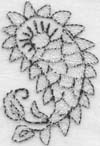Section 12 == *script chart*; *positional chart*; *more help*
12.1 = the diacritic khaṛā
zabar
The diacritic khaṛā zabar , "upstanding zabar," looks like a slightly longer and perfectly vertical version of zabar . In some Arabic words it is caused to float in the air above the word, with no "chair," and replaces a full normal alif . A word like raḥmân (most merciful) may be written as one would expect, with a normal alif between the mīm and the nūn , or else simply with a mīm + nūn on the line, and a khaṛā zabar floating above the word between the two letters. Fortunately you need only recognize this when you see it, you don't need to learn to do it yourself unless you want to write in a particularly Arabicized way.
12.2 = the construction tanvīn
The construction tanvīn , "nuunation," is a word-final form that looks like an alif with two small parallel and diagonal zabar marks floating above and after it. When you see this odd effect you know: first, that the word is Arabic; second, that it’s an adverb; and third, that the alif with its zabar adjuncts will be pronounced exactly like a nūn (and scanned that way in poetry, too). The common adverb faur;an (immediately) is written with a tanvīn . The tanvīn is not optional: when you write words in which it belongs, you have to use it.
12.3 = the letter alif-e maqṣūrah
The letter alif-e maqṣūrah , "shortened alif," always occurs in word-final position and sits on a "chair" consisting of a final chhoṭī ye . It indeed looks like about half of an alif , and it floats in the air directly above its "chair." The alif-e maqṣūrah and the "chair" together combine to make the equivalent of a word-final alif . This letter can be seen at the end of certain Arabic names like lailâ (Laila) and mūsâ (Moses). Where it occurs, it is part of the basic spelling of the word and must be used.
12.4 = the letter vāʾo-e maʿdūlah
The vāʾo-e maʿdūlah , "distorted vāʾo , is a vāʾo found in certain Persian words that is written normally but is barely heard. It may be shown by a diacritic consisting of a small horizontal slash placed below the vāʾo in question, but don't bet on it; usually people don't bother to provide this diacritic. As so often, the real way you recognize its presence is by knowing the word in which it appears.
If you're reading poetry, you're home free, because it's metrically invisible, so the word it's in will be scanned just the way if would be if the vāʾo-e maʿdūlah were absent. (It's also pronounced that way: maybe just a small hint of the vāʾo sound, but well less than 50%, so that if you had to round it off, you'd round it off to inaudibility.)
Common words that contain such a suppressed vaa))o are ḳhvud (oneself), tanḳhvāh (salary), ḳhvāb (dream).
